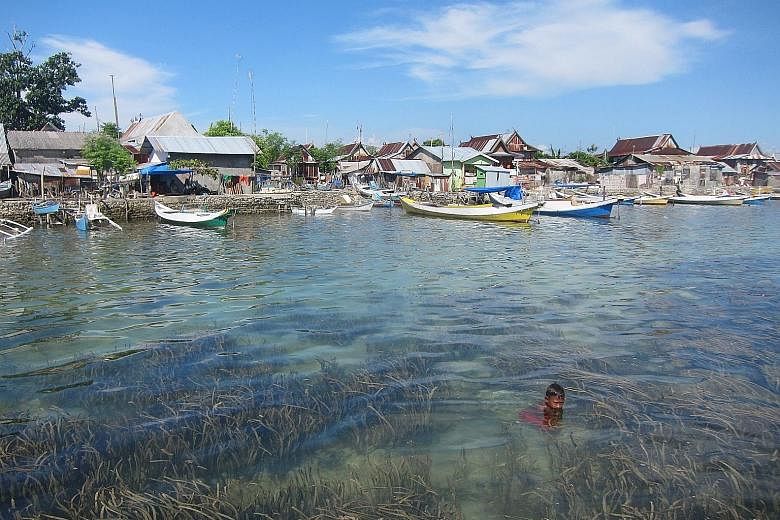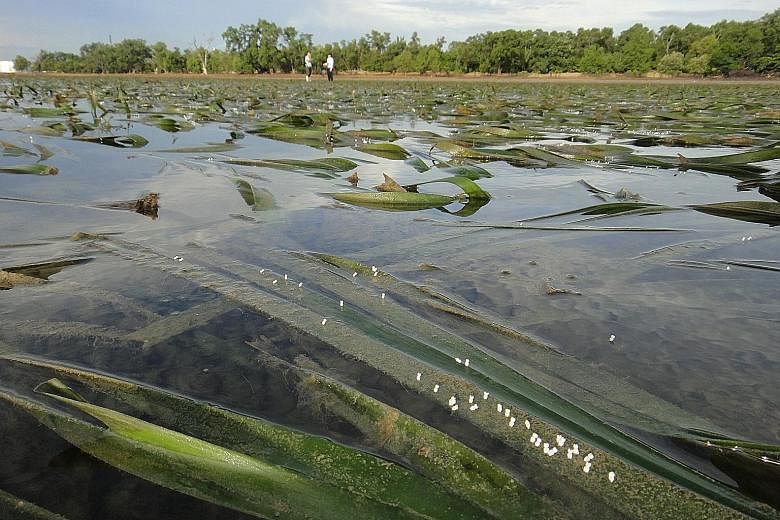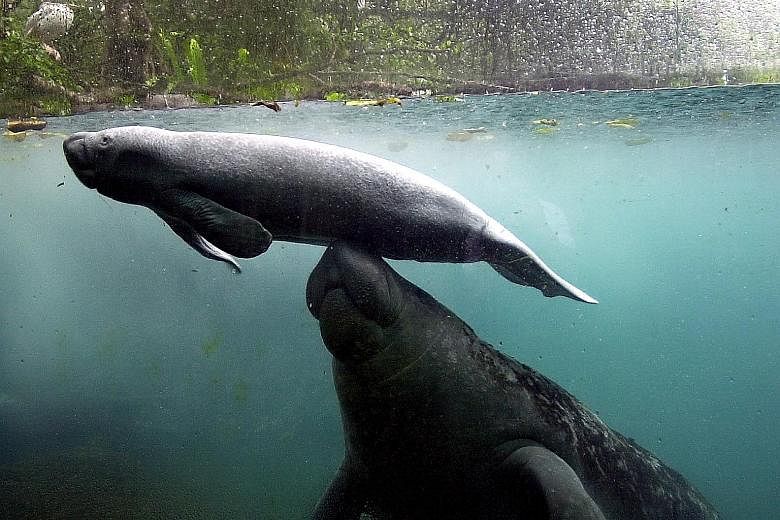Every continent except Antarctica is ringed by vast stretches of seagrass, underwater prairies that together cover an area roughly equal to California.
Seagrass meadows, among the most endangered ecosystems on earth, play an outsize role in ensuring the health of the oceans. They shelter important fish species, filter pollutants from seawater, and lock up huge amounts of atmosphere-warming carbon.
The plants also fight disease, it turns out.
Scientists reported recently that seagrasses can purge pathogens from the ocean that threaten humans and coral reefs alike. (The first hint came when the scientists were struck with dysentery after diving into coral reefs without neighbouring seagrass.) But the meadows are vanishing at a rate of a football field-sized patch every 30 minutes.
Dr Joleah Lamb, a postdoctoral researcher at Cornell University and lead author of the new study, said she hoped it would help draw attention to their plight. "We call seagrass the ugly stepchild of marine organisms," said Dr Lamb. "They don't get a lot of respect, compared to corals and mangroves."
Seagrass first evolved tens of millions of years ago, when some flowering plants moved from land into the ocean. They still grow flowers, pollen and seeds, but they now do so underwater, with a powerful form of photosynthesis that allows them to thrive in dim light at depths of up to 58m.
The sediment in which they grow is loaded with deadly hydrogen sulfide. They detoxify by pumping some of the oxygen they release during photosynthesis into their roots.
With these adaptations, seagrass meadows became more productive than today's fertilised cornfields. As they spread, the meadows altered the sea floor, building soil and supporting entirely new ecosystems. Animals like manatees and juvenile fish took up residence.
"Killer whales are a big tourist attraction, but people probably don't realise that seagrass beds are really important as nurseries for the fish that the salmon require, which the killer whales require," said Dr Drew Harvell, a marine biologist at Cornell University and senior author of the new study.
Humans depend on these nurseries, too. Many of the species harvested in commercial fisheries begin life in seagrass meadows. Without them, fishermen would catch far less, and make less money.
In 2014, Cambridge University researchers studied seagrass meadows in southern Australia to estimate the value they bring to the fisheries industry. They estimate each acre (0.4ha) of seagrass adds about US$87,000 (S$123,000) per year.
The plants also draw fertiliser runoff and other pollutants out of the water, locking them safely away in meadow soil. Scientists have estimated that 0.4ha of seagrass provides more than US$11,000 worth of filtering every year.
These services alone would make seagrass meadows among the most economically valuable ecosystems on earth. But now Dr Harvell and her colleagues have found that these plants may help us in another way: by wiping out pathogens.
Their new study, published in the journal Science, began with a scuba-diving trip in Indonesia. The scientists were inspecting coral reefs for infections with bacteria and fungi; some reefs are increasingly falling prey to these diseases.
"By the end of the four-day workshop, we all came down with amoebic dysentery," recalled Dr Harvell.
"One scientist developed typhoid, and we had to ship her out."
The experience left Dr Harvell wondering if the illnesses of the scientists might somehow be connected to those of the reefs. "It just got me thinking about human health and environmental health and how they're linked," she said.
She discussed the idea with Dr Lamb, who began to investigate.
Seagrass meadows can release so much oxygen that the surrounding water fizzes like champagne. That oxygen might be able to kill pathogens, Dr Lamb realised. The plants also host fungi, which are known to produce bacteria-killing compounds. Dr Lamb and her colleagues decided to study sites around four islands in Indonesia with and without nearby seagrass. The scientists devised two strategies to search for pathogens.
In one survey, they collected seawater and put it in petri dishes to see if colonies of disease-causing bacteria known as enterococcus grew from the samples. Levels of the bacteria in water from seagrass meadows, they found, were a third of the levels in water from other sites.
In a second search, the scientists grabbed fragments of DNA in the seawater. By examining the sequences, they identified 18 kinds of disease-causing bacteria. Water from the seagrass meadows had only half the level of this DNA, compared with water collected at other sites.
The scientists next turned their attention to coral reefs around the islands. Reefs next to seagrass meadows, they found, were half as diseased as those without meadows. Dr Robert Orth, a seagrass expert at the Virginia Institute of Marine Science who was not involved in the new report, predicted it would lead to similar research on seagrass meadows in other parts of the world.
"It's going to make people think," he said.
The growing recognition of this plant's importance comes even as it is disappearing.
Nearly one-third of the world's seagrass meadows have died since the 19th century. Studies indicate that they are disappearing at an accelerating pace.
Dr Orth and his colleagues have published a detailed study of the retreat of seagrass in Chesapeake Bay - an estuary in the United States - in the journal Global Change Biology.
Since 1991, they estimate, 29 per cent of the bay's seagrass meadows have vanished.
Their research points to two main culprits. Eroded dirt washes into the Chesapeake, making the water cloudy.
Seagrass gets so little sunlight that the resulting dimming can be deadly. Seagrass is also being pummelled by climate change. Warmer summer temperatures in Chesapeake Bay cause the plants to lose much of their oxygen through their leaves.
With less oxygen to pump into their roots, they are poisoned by toxic sediments.
The cloudiness of the water makes the heat even worse. With less sunlight, the plants produce even less protective oxygen to begin with. "We have a double whammy," said Dr Orth.
As the underwater meadows disappear, economic value disappears with them. The Chesapeake Bay meadows are a nursery for blue crabs, for example. Dr Orth and his colleagues estimate that the seagrass die-off has eliminated more than 500 million juvenile blue crabs since 1991.
Seagrass meadows can store enormous amounts of carbon. Their soils do not decompose because they have very little oxygen in them. As a result, seagrass meadow soil around the world has accumulated an estimated nine billion tonnes of carbon.
As seagrass meadows disappear, that carbon is being released back into the ocean. Some of it may make its way into the atmosphere as heat-trapping carbon dioxide.
As dire as the situation has become, there is cause for hope. In recent years, Dr Orth and his colleagues have successfully restored seagrass meadows off the coast of Virginia. "Now we have 2,500ha of seagrass, where in 1997 there wasn't a single blade of grass," he said.
NYTIMES



